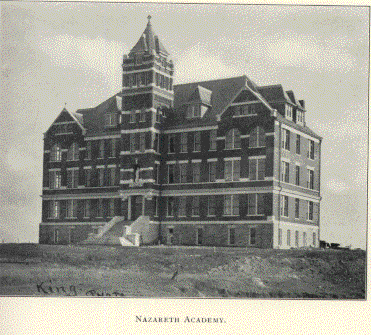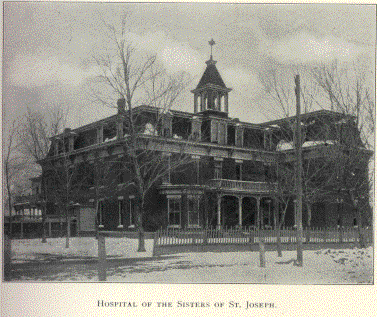
Nazareth Academy.
A boarding school for the practical education of young ladies, with a kindergarten and preparatory department for girls, was established in the year 1884, under the supervision of the Sisters of St. Joseph. The school thrived under their care until it has become one of the most successful in the state. The scope of work included in their curriculum is of a high standard, and every teacher loyally strives with that earnest devotion so characteristic of the sisters to develop every young student into the noblest and most Intellectual womanhood. They are trained to think for themselves, and women go out from this institution of learning who not only grace the highest society with their accomplishments, but dignify and honor it by their many personal charms and virtues, and also fit them, should conditions and circumstances demand it, to gain in independent livelihood.
In 1901 the foundation of the Nazareth Academy was laid and the present writing (January, 1903) finds the elegant new building almost ready for occupancy. The structure, which is of brick and stone, is situated on the hill at the south end of Washington street, and is one of the most imposing in the northwest part of the state. The building site is one of the finest in the country, and the convent can be seen for miles around. The architecture, like the cathedral, is Gothic, and like that stately edifice, the same style is applied throughout the convent. The present prosperous school has outgrown its site and facilities, necessitating more commodious quarters, and the new academy is the outgrowth of this need.
The building was designed by William P. Feth, a Lawrence architect. The foundation is one hundred and thirty feet with a depth of one hundred and nineteen feet. It is four stories in height, with a basement. The tower in the center of the building ascends to a height of one hundred and twenty-five feet. The exterior of the basement is of stone, and the interior is handsomely finished in yellow pine. In this part of the structure is the students' dining room, the secretary's office, cloak room, wine room, toilet rooms, kitchen quarters, storage room, boiler and coal room. Here, also, is a room with a stage to be used in histrionic art entertainments pertaining to the academy. Ornamental steps of stone precede the entrance to the main building and through a beautiful vestibule into the main hall. On one side and opposite the entrance the main stairway begins and extends to the top of the academy. There is another stairway in the rear, which begins in the basement reaching the top floor and is enclosed on its four sides by brick walls, as a safeguard against fire.
The parlor and reception rooms are on the first floor, and also the library, which will be stocked with the best books and literature obtainable. There are three music rooms on this floor, where the best instructors will be employed in all branches of the art. The chapel, which is situated at the end of the main hall, is two stories high, with vaulted ceilings; a balcony gives entrance through the second story of the main building. Upon the second floor will be found the bath and toilet rooms equipped with the latest improved plumbing. On this floor is also the novitiate rooms, locker rooms, sisters' apartments, three music rooms and an art studio.
Between the dispensary and two infirmaries, which are included in this floor, there will be a private bath for patients only. The third floor is divided into two dormitories for girls, a sisters' dormitory, private sleeping department, locker rooms, lavatory and bath rooms. The fourth story will be devoted to locker, trunk and storage rooms. That very necessary adjunct, the kitchen, is all that the most fastidious chef could desire. In time the grounds, now rough and broken by the debris of building material, will be made beautiful with spacious lawns, decorated with bright-hued flowers, fit emblems of the sacred lives of the Sisters of Nazareth Academy.
After the removal of the school to their new quarters the convent building, now used by the Sisters of St. Joseph will be converted into a hospital - a much needed factor in the city of Concordia, and one that will prove a lasting benefit. The Sisters are not only appreciated for the consecration of their devoted lives to ideal christian work, but are beloved by all denominations and classes of people for their untiring and faithful ministrations to the sick and to the needy. In the capacity of teachers their standard is of the highest, spiritually and in an educational way they are unexcelled.

Hospital of the Sisters of St. Joseph
In the entire history of the county no enterprise has been more timely than the founding of this institution by the Sisters of St. Joseph. The building to be used for hospital services is the old Nazareth Academy, which is situated just east of the cathedral and recently vacated by the removal of the school to their magnificent and commodious new quarters, on the hill at the foot of Washington street. The building, a brick structure, surrounded by trees and a well-kept lawn, is being remodeled, thoroughly equipped with the latest appliances, a fine operating room, capacity for one hundred beds and fitted with every advantageous facility known to modern methods in medicine and surgery. While Dr. W.R. Priest will be surgeon of the hospital, it will be a general establishment open to all the physicians of the county.
CONCORDIA BIOGRAPHIES
![]()
Transcribed from E.F. Hollibaugh's Biographical history of Cloud County, Kansas biographies of representative citizens. Illustrated with portraits of prominent people, cuts of homes, stock, etc. [n.p., 1903] 919p. illus., ports. 28 cm.
New Index
A | B | C | D | E | F | G | H | I | J | K | L | M | N | O | P | Q | R | S | T | U | V | W | Y | Z
